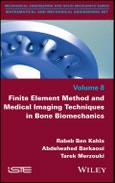Table of Contents
Introduction ix
Chapter 1. Main Medical Imaging Techniques 1
1.1. Introduction 1
1.2. X-ray imaging 2
1.2.1. Definition of X-rays 2
1.2.2. X-ray instrumentation and generation 4
1.2.3. Applications of X-ray imaging 7
1.2.4. Advantages and disadvantages of X-ray imaging 14
1.3. Computed tomography 14
1.3.1. Description of the technique 15
1.3.2. Development of computed tomography 16
1.3.3. Instrumentation 17
1.3.4. Applications 22
1.3.5. Advantages and disadvantages of computed tomography 25
1.4. Magnetic resonance imaging 25
1.4.1. Instrumentation 26
1.4.2. Generation of the resonance effect 27
1.4.3. Relaxation and contrast 30
1.4.4. Applications of magnetic resonance imaging 33
1.4.5. Advantages and disadvantages of magnetic resonance imaging 36
1.5. Ultrasound imaging 36
1.5.1. Definition of ultrasound 36
1.5.2. Development of ultrasound imaging 37
1.5.3. Generation of ultrasound 38
1.5.4. Transducers 39
1.5.5. Applications of ultrasound techniques 42
1.5.6. Advantages and disadvantages of ultrasound imaging 47
1.6. Comparison between the different medical imaging techniques 47
1.7. Conclusion 48
Chapter 2. Medical Image Analysis and Processing 49
2.1. Introduction 49
2.2. Image compression 49
2.3. Image restoration 50
2.4. Image enhancement 50
2.4.1. Window and level 51
2.4.2. Gamma correction 51
2.4.3. Histogram equalization 52
2.4.4. Image subtraction 52
2.4.5. Spatial filtering 52
2.5. Image analysis 53
2.5.1. Texture features 53
2.5.2. Edges and boundaries 55
2.5.3. Shape and structure 57
2.6. Image segmentation 58
2.6.1. Simple methods of image segmentation 58
2.6.2. Active contour segmentation 60
2.6.3. Variational methods 61
2.6.4. Level set methods 62
2.6.5. Active shape and active appearance models 62
2.6.6. Graph cut segmentation 63
2.6.7. Atlas-based segmentation 63
2.6.8. Deformable model-based segmentation 65
2.6.9. Energy minimization-based segmentation 65
2.6.10. Learning-based segmentation 65
2.6.11. Other approaches 66
2.7. Image registration 66
2.7.1. Dimensionality 67
2.7.2. Nature of the registration basis 68
2.7.3. Nature of the transformation 69
2.7.4. Transformation domain 70
2.7.5. Interaction 71
2.7.6. Optimization procedure 72
2.7.7. Modalities involved 72
2.7.8. Subject 73
2.7.9. Object 74
2.8. Image fusion 74
2.8.1. Pixel fusion methods 74
2.8.2. Subspace methods 75
2.8.3. Multi-scale methods 75
2.8.4. Ensemble learning techniques 75
2.8.5. Simultaneous truth and performance level estimation 76
2.9. Image understanding 76
2.10. Conclusion 76
Chapter 3. Recent Methods of Constructing Finite Element Models Based on Medical Images 79
3.1. Introduction 79
3.2. X-ray-based finite element models 79
3.3. CT-based finite element models 89
3.4. MRI-based finite element models 117
3.5. Ultrasound-based finite element models 121
3.6. Conclusion 124
Chapter 4. Main Bone Sites Modeled Using the Finite Element Method 125
4.1. Introduction 125
4.2. FE modeling of the calcaneus 125
4.3. FE modeling of phalanges 127
4.4. FE modeling of the metatarsal 129
4.5. FE modeling of the tibia 131
4.6. FE modeling of the knee 137
4.7. FE modeling of the femur 140
4.8. FE modeling of the vertebrae 143
4.9. FE modeling of the humerus 147
4.10. FE modeling of the elbow 149
4.11. FE modeling of the ulna 149
4.12. FE modeling of the wrist 150
4.13. Conclusion 152
Conclusion 153
References 155
Index 179








